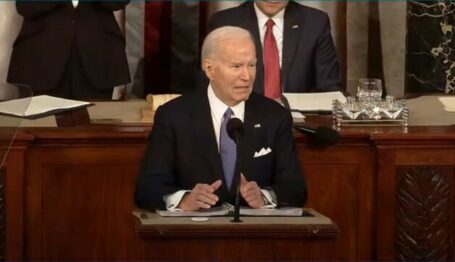Labor Watch
Big Labor’s Decline and Left Turn: Causes of the Long Decline
 Walter Reuther’s hostility to George Meany, the long-standing head of the AFL-CIO, ultimately led to a break in the late 1960s. Credit: Ransdell Inc. License: https://bit.ly/4b6UJzC.
Walter Reuther’s hostility to George Meany, the long-standing head of the AFL-CIO, ultimately led to a break in the late 1960s. Credit: Ransdell Inc. License: https://bit.ly/4b6UJzC.

Big Labor’s Decline and Left Turn: The Government Workers Rise and Labor’s Center Falls (full series)
A New Power Rises | Labor’s Private-Sector Left | Causes of the Long Decline
A Trade Unionist in the White House | Membership Decline
Labor’s Love Lost: Causes of the Long Decline
By 1979, when Lane Kirkland succeeded George Meany as head of the AFL-CIO, fundamental changes to the economy had led to a decline in the unionized share of the private economy that continues to this day. The rise of American organized labor, which had marched upward with little to impede it either politically or economically relied on a series of historical contingencies in the Great Depression and immediate post–World War II eras that were coming apart by the 1970s and 1980s and have since collapsed completely.
To the extent there was a political consensus around the New Deal political economy in the immediate postwar period, the social radicalism of the 1960s and the expansions of government under the Great Society ended it. The “Three Bigs” model of Big Government, Big Corporations, and Big Labor working together from the New Deal and World War II eras could not survive the increasing fragmentation of American society. Debates over where the civil rights movement would go after the enactment of the Voting Rights Act (think of Martin Luther King Jr.’s increasingly left-wing economic campaigning or debates over busing in northern school districts), the Vietnam War, rising crime, and increasing sexual libertinism fueled a conservative comeback.
Politically, the wages of 1968 were President Richard Nixon. While Nixon was liberal by the standards of his Republican successors on political economy, and Nixon did notable favors for the Teamsters’ Jimmy Hoffa, his election slowed the advance of political leftism at the federal level. In this way his presidency functioned like the “conservative coalition” in Congress had functioned under Franklin Roosevelt. While unable and unwilling to reverse the changes that had already happened, the government would not engage in more “bold, persistent experimentation” to grow state power.
Politics wasn’t the only thing to change at the end of what the French and nostalgists for a French-style state-managed economy call the “thirty glorious years.” The world economy was not what it was at the end of World War II either. Labor contracts like those negotiated as part of Reuther’s Treaty of Detroit set wages and other labor costs on a constant upward track. Combined with declining productivity growth rates, loose monetary policy, and surging government expenditures, these “wage-price spiral” pressures drove inflation even as economic growth slowed, creating the befuddling “stagflation” for which the then-dominant theories of Keynesian economics had no answer.
Abroad, the international economic picture had also changed wildly since the immediate post–World War II period. Western Europeans had benefitted from American Marshall Plan aid that kept the Soviet communists out and rebuilt the industrial bases destroyed by aerial bombardment and brutal land warfare. In 1946, Japan was a defeated, twice-nuked (and capital-firebombed) former Axis Power under U.S. military occupation, but by the late 1970s it had become an industrial powerhouse exporting cars that Americans and other Westerners were suggesting sotto voce might be better than their own domestic production.
Energy was more expensive. At the end of the World War II, the United States was a major oil producer, with geostrategic reserves that the country could wield against foes like the Axis Powers or friends alike. The 1957 Suez Crisis, in which the French, British, and Israelis responded militarily to the seizure of the Suez Canal by the Egyptian government of Gamel Abdel Nasser, ended in Egypt’s favor when the Eisenhower administration refused to offer emergency oil supplies to the British, among other financial pressures it levied on the Western powers.
But by the mid-1970s, American production had peaked and begun a decline that would only reverse with the “fracking boom” of the 2010s. The balance of energy power moved from West Texas to the Arab Middle East, and when the now-Soviet-backed Egypt and Syria went to war with the now-U.S.-allied Israel in the Yom Kippur War, America faced the pain of the “oil weapon.” Arab states embargoed oil sales to the U.S., causing a shortage. The price of oil more than doubled. Further conflicts in the Middle East through the 1970s and 1980s would drive the price up even higher.
And a new power had risen in the economy and was now demanding consideration in policy: the American consumer. Big Labor had risen in an environment of privation and war, but the country now identified with—and demanded—plenty and peace. The late 1970s and early 1980s saw the American consumer flex its power, demanding that something—anything—be done to curtail rampant inflation. After the predictable failure of wage and price controls enacted by the Nixon administration and the pathetic “Whip Inflation Now!” campaign of the Gerald Ford administration, a bipartisan consensus emerged, first under Jimmy Carter, in favor of deregulating the national economy. The results were excellent for American consumers and the rising share of services-industry workers. They fell harder on heavily unionized regulated industries like long-haul trucking and international airlines.
In the next installment, in 1980 a former union leader—Ronald Reagan—was elected president, who broke the illegal strike called by the air traffic controllers’ union.



